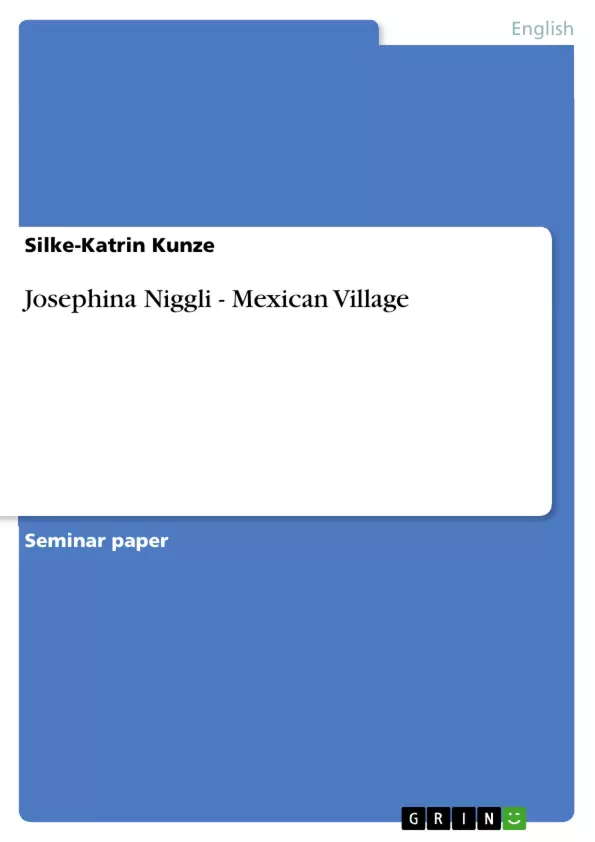Introduction
Chicano/a Movement & Chicano/a Literature
As there are some people who have never heard the term Chicano/a, it is of utmost importance to start out with a definition. Chicanos are people of Mexican descent who live in the United States. They were either born there or immigrated with their families. Therefore a Chicano may seem like a Mexican-American. The difference is that the first term implies cultural awareness, whereas the other is rather neutral.
In Chicano/a writing the essence not only is that the author is a Chicano/a, he or she even plants Chicano characters into a Chicano environment who use Chicano speech patterns. The first pieces of Chicano literature were produced after the Mexican War (1848), so that this is actually a rather young field of research. The origins, however, already lie in the late 16th century, when the Spaniards spread their language and religion, etc. From that background folktales and legends evolved, among them La Llorona, the weeping woman. In fact, many Chicano works of fiction revolve around her.
Historically important here is the Treaty of Guadelupe-Hidalgo from 1848. After the so-called Mexican War (1846-1848), Mexico had to cede large parts of its land, much of the Mexican Southwest (Texas, New Mexico, Arizona, Colorado, California), to the U.S., and in the short run those Mexicans who lived there had to choose between either Mexican or American citizenship. It is their descendants who later developed poetry, narratives and corri-dos. Corridos are ballads in Spanish, altogether forming a cultural history. Up to the present day, they have not ceased to exist.
By 1900, Chicano literature played a role in the United States. Since many Mexican-Americans spoke Spanish and were catholic, those two were its first features. Around the same time also the first novels and stories were published. Things changed in 1945 at the latest, with the appearance of Josephina Niggli′s Mexican Village. Influenced by the Civil Rights Movement in the 1960s (also the time of the so-called Chicano Movement [1965-1975]), Chicano publishing houses were founded. Only then could the literary field spread its wings and make way for movies and plays. A more recent development is the emergence of strong Chicana writing, aiming at voices of Mexican or Mexican-American women finally being heard and thus among others dealing with Mexican icons such as La Malinché, the Virgin of Guadelupe and the aforementioned La Llorona.
[...]
Inhaltsverzeichnis (Table of Contents)
- Introduction
- Chicano/a Movement & Chicano/a Literature
- "Mexican Village"
- Josephina Niggli
- Biography
- Mexico vs. USA
- Mexican Village
- The Quarry: Bob Webster
- The River Road
- Women's Status: María vs. Evita
- The Mexican Revolution
- The Street of the Forgotten Angel
- The Castillo Family
- Roberto Ortega Menéndezy Castillo, Formerly known as "Bob Webster"
- Summary
Zielsetzung und Themenschwerpunkte (Objectives and Key Themes)
The main objective of this paper is to provide an in-depth analysis of Josephina Niggli's novel "Mexican Village" and explore its significance within the context of Chicano/a literature. The paper aims to understand the author's intention to portray Mexican culture authentically for American readers, analyze the representation of Mexican characters and their cultural heritage, and examine the novel's social and political implications.
- The portrayal of Mexican culture and identity in Chicano/a literature
- The role of folklore and traditional elements in Niggli's writing
- The social and political landscape of Mexico in the early 20th century
- The representation of women's status and power in Mexican society
- The impact of the Mexican Revolution on Mexican culture and identity
Zusammenfassung der Kapitel (Chapter Summaries)
The introduction delves into the concept of Chicano/a identity and literature, highlighting the historical context and cultural roots of this literary movement. It traces the development of Chicano/a writing, emphasizing the significance of the Mexican War (1848) and the emergence of Josephina Niggli's "Mexican Village" as a pivotal work.
The chapter on "Mexican Village" explores the novel's setting in Hidalgo, Mexico, and its focus on the lives of its inhabitants from 1920 to 1930. Niggli's use of Mexican folklore, proverbs, and occasional Spanish syntax is discussed, emphasizing her aim to convey an authentic sense of Mexican culture to American readers.
The chapter on "Josephina Niggli" provides biographical information about the author, highlighting her personal connection to Mexico and her experiences in both the United States and Mexico. It mentions Niggli's early literary endeavors, including her poetry and short stories, and her later work in drama and journalism.
The chapter on "Mexico vs. USA" examines the historical and social context of the Mexican American experience, highlighting the impact of the Mexican War and the Treaty of Guadalupe-Hidalgo. It explores the cultural tensions and challenges faced by Mexican Americans and their evolving identity within the United States.
The chapters on "The Quarry: Bob Webster," "The River Road," "Women's Status: María vs. Evita," and "The Mexican Revolution" explore various aspects of life in Hidalgo, including the importance of the mining quarry, the role of women in society, and the impact of the Mexican Revolution on the local community.
The chapter on "The Street of the Forgotten Angel" focuses on the themes of spirituality, superstition, and the supernatural within Mexican culture. The character of Tia Magdalena, an eagle witch, is introduced, highlighting her power and influence in the community.
The chapter on "The Castillo Family" centers around the family dynamics and relationships within the community, exploring themes of love, loyalty, and tradition. The chapter on "Roberto Ortega Menéndezy Castillo, Formerly known as 'Bob Webster'" sheds light on the complexities of identity and assimilation, highlighting the impact of American culture on Mexican individuals.
Schlüsselwörter (Keywords)
The main keywords and focus topics of the text include Chicano/a literature, Mexican American identity, Josephina Niggli, "Mexican Village," folklore, cultural heritage, Mexican Revolution, women's status, social and political landscape of Mexico, and assimilation.
- Quote paper
- Silke-Katrin Kunze (Author), 2002, Josephina Niggli - Mexican Village, Munich, GRIN Verlag, https://www.grin.com/document/4289



